Introduction
Cumulocity can interface with LoRa devices through Actility’s ThingPark Wireless, Enterprise or Community edition. You can:
- Provision and deprovision LoRa devices easily using the Cumulocity Device management application. No interaction in the ThingPark user interface is required.
- Decode upstream payload packets using a web-based user interface.
- Debug and postprocess raw device data through Cumulocity events.
- Send downstream data to the device using Cumulocity operations.
- Make use of existing Cumulocity features with LoRa devices, for example: connectivity monitoring, device management, data visualization with dashboards, real-time analytics and more.
The following illustration gives an overview of the Cumulocity Actility LoRa integration.
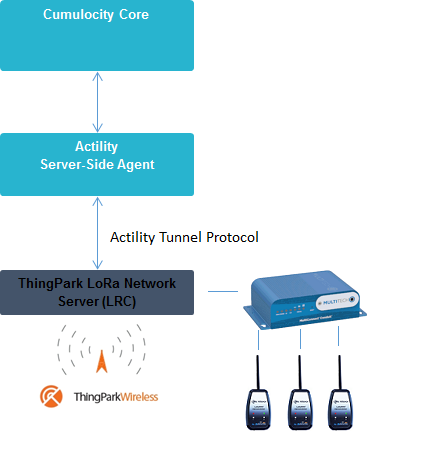
Configuring multiple ThingPark account connections
Before using LoRa devices with Cumulocity, you need to configure your ThingPark account details in the Administration application. Click the Connectivity tab in the Settings menu to create, edit, delete or update multiple Actility connections.
To add a new connection
If you select Connectivity for the first time, you are asked to create a connection. Click Add Connection.
Enter the following information:
- Name: The name of the Actility connection being created.
- Description: The description of the Actility connection being created.
- Actility ThingPark URL: The Actility ThingPark URL may change based on the type of the Actility ThingPark account we use (for example, Wireless, Community or Enterprise edition).
- Profile ID: This depends on your ThingPark account and environment. If you are using, for example, the Dev1 ThingPark environment your profile ID will be “dev1-api”. Multiple tenants can have the same profile ID.
- Application Server ID: Application server ID that will be used for TLS security between the ThingPark platform and the agent. This is an optional field. Leave empty to disable security. If it’s enabled, then the agent will generate a token and use it for all the uplink and down-link messages.
- Application Server Key: Application server private key that will be used for TLS security between the ThingPark platform and the agent for the uplink and downlink communications. Value should be in hex and 16 bytes. This is an optional field. Leave empty to disable security. If it’s enabled, then the agent will generate a token and use it for all the uplink and down-link messages.
- Admin API version: The version that the ThingPark admin API uses. By-default it will be set to “latest”.
- Core API version: The version that the ThingPark core API uses. By-default it will be set to “latest”.
- Username: Your ThingPark account username.
- Password: Your ThingPark account password.
- Connection Type: The ThingPark account type that is being used. It can be either Enterprise or Wireless.

Click Save. If you have entered the correct information, you see the message “Connection created”.
To add another connection, click Add Connection and follow the steps above.
To update a connection
Select the connection to be updated, make your edits, and save the connection.
If there are devices associated with the connection, an error message will appear, stating “Can not update the LNS Connection with <name of LNS Connection> as it’s associated with <number of devices>. Click the link to download the file with the details of the associated devices: /service/<agent-context-path>/lns-connection/<lns-connection-name>/device”.
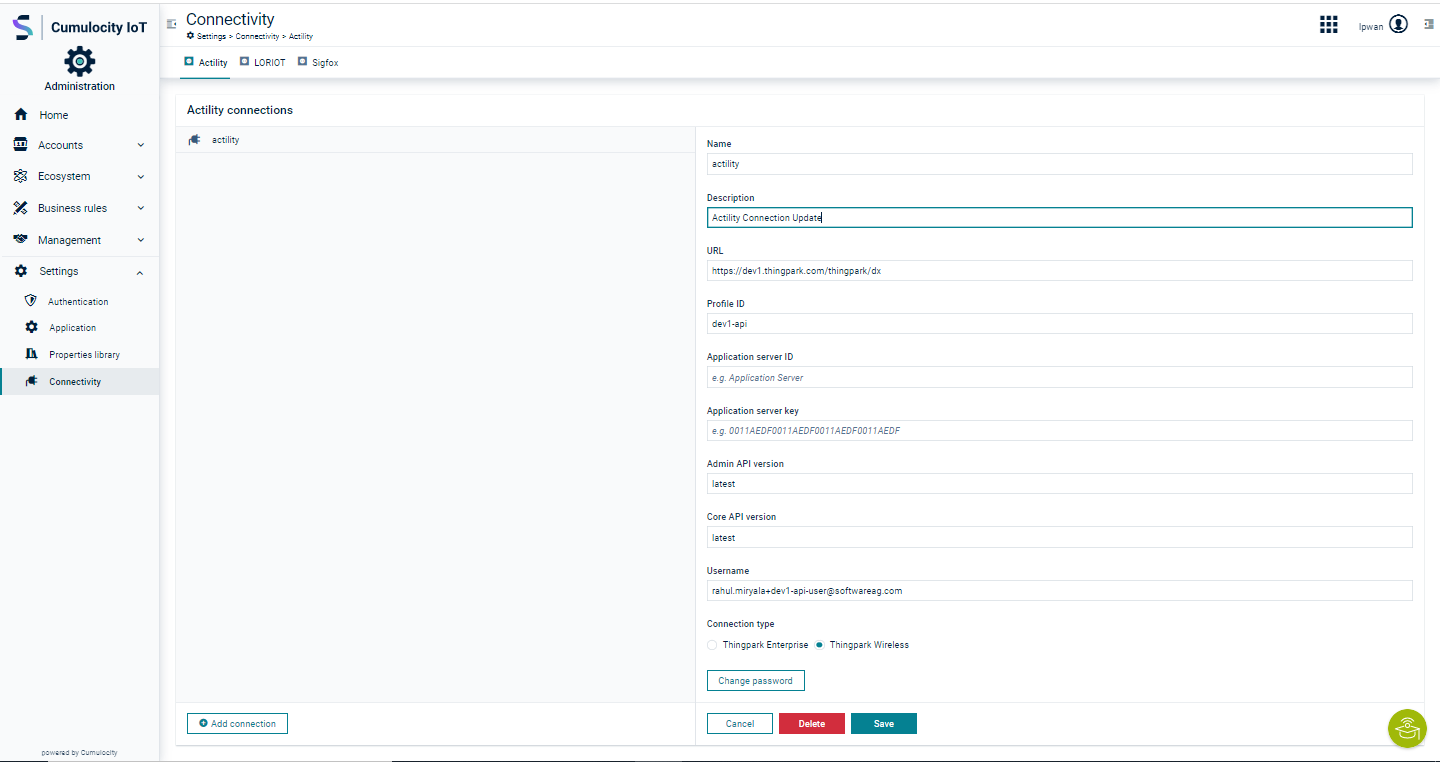
To delete a connection
Select the connection to be deleted and click Delete.
If there are devices associated with the connection, an error message will appear, stating “Can not delete the LNS Connection with <name of LNS Connection> as it’s associated with <number of devices>. Click the link to download the file with the details of the associated devices: /service/<agent-context-path>/lns-connection/<lns-connection-name>/device”.
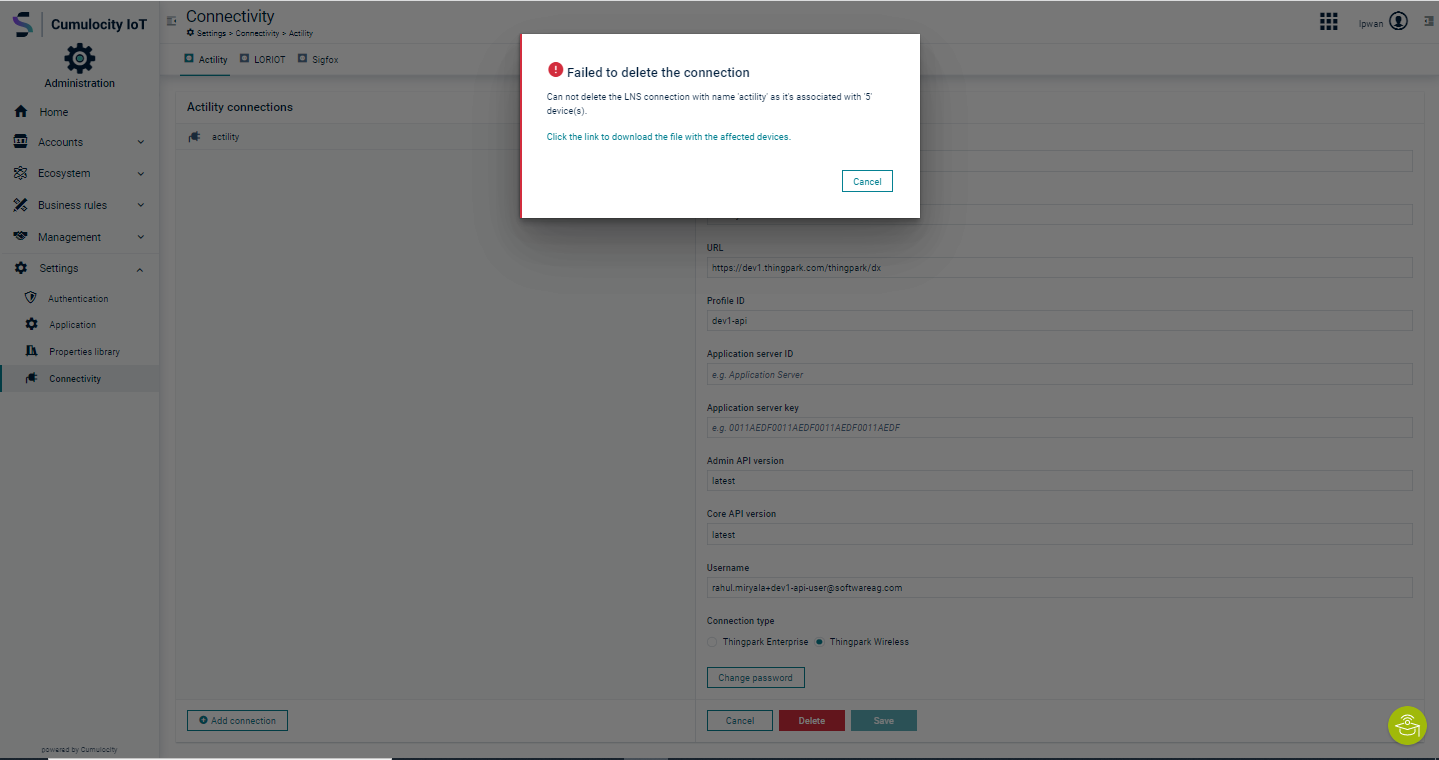
Creating device protocols
To process data from LoRa devices, Cumulocity needs to understand the payload format of the devices. Mapping a payload data to Cumulocity data can be done by creating a LoRa device protocol.
During the device registration, you can associate this device protocol. The received uplink callbacks for this device with a hexadecimal payload will then be mapped to the ones you have configured in your device protocol.
The device protocol assigned during device registration can be changed from the LPWAN tab in the device details page.

In order to create a device protocol, navigate to the Device management application and select Device protocols in the Device types menu in the navigator. You can either import an existing device protocol or create a new one or use the device protocols created by an LPWAN custom codec microservice.
Importing a predefined device protocol
In the Device protocols page, click Import.
Select the predefined device type, for example “LoRaWAN Demonstrator” or upload from a file. Click Import.
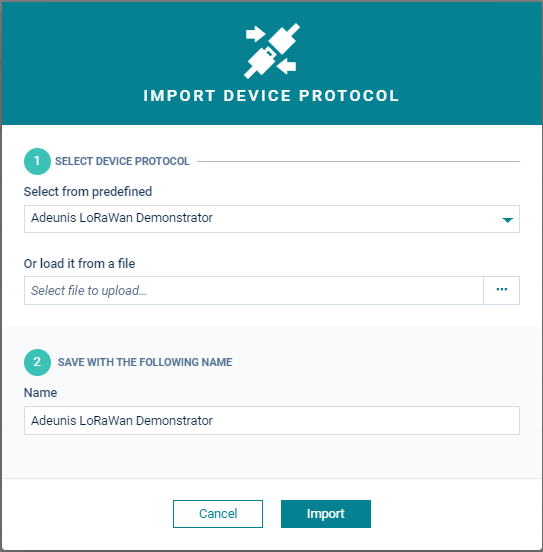
Alternatively, you may also load the device protocol from a file and import it.
Creating a new device protocol
In the Device protocols page, click New device protocol in the top menu bar. The following window will open:
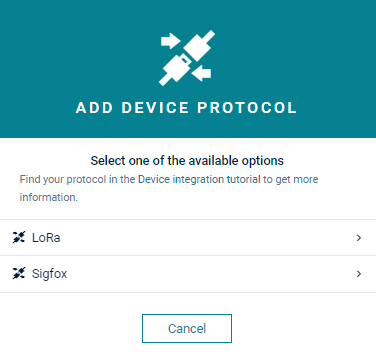
Select LoRa as the device protocol type, provide a name for it and click Create.
Under Message types, specify the message types. LoRa devices can send messages of different types with different encodings per type.
Select the way the message type is encoded in the Source dropdown box:
- FPort: if the message type can be determined by looking at the FPort parameter of a message.
- Payload: if the message type can be determined by looking at the subset of the message payload itself.
In the following example payload structure, the first byte indicates the message type source (as highlighted).

In the user interface you can enter this type of message type source information as follows: In the Start bit field, indicate where the message type information starts in the payload and in the Number of bits field, indicate how long this information is, for example start bit = “0” and number of bits = “8”.
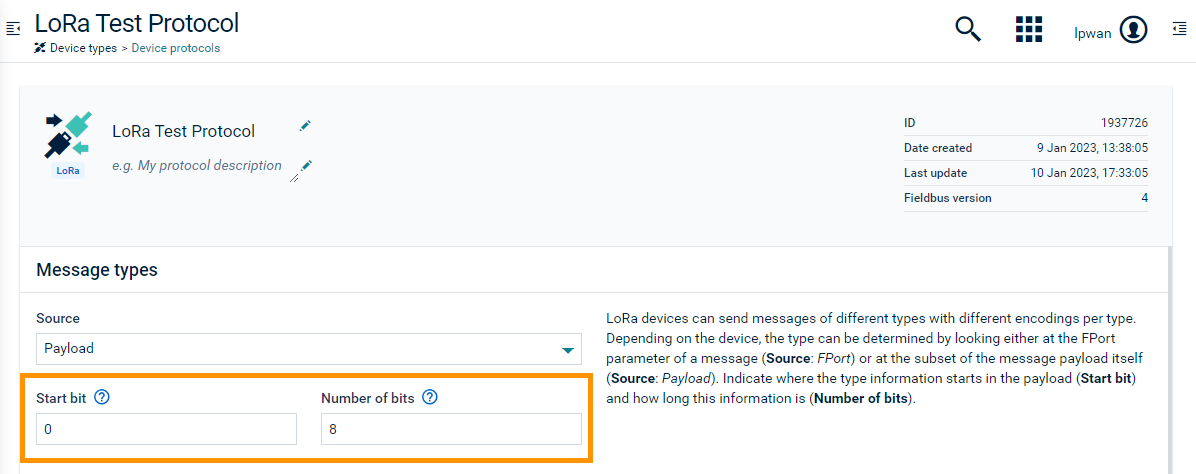
Click Add value to create the value configuration.
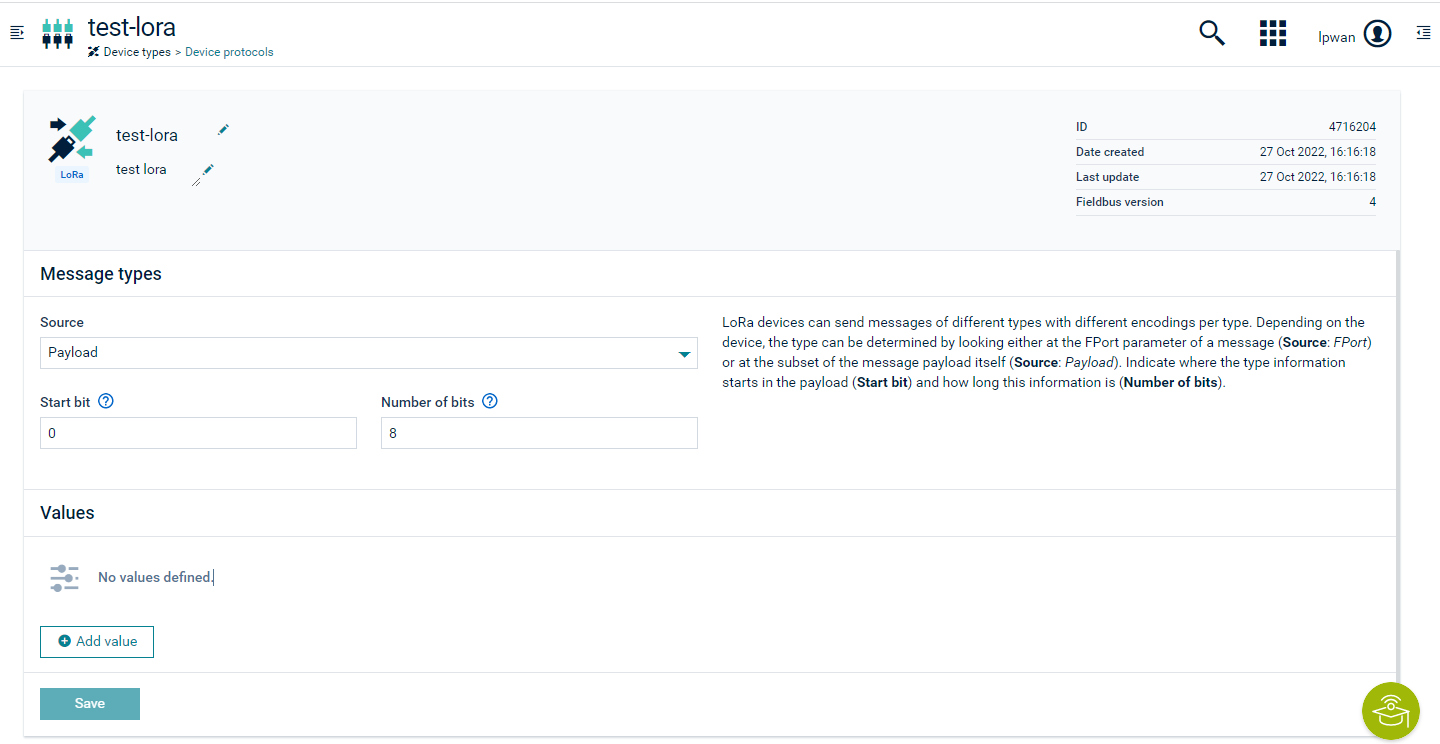
In the upcoming window, configure the relevant values as shown in this example.
New value window part 1

New value window part 2
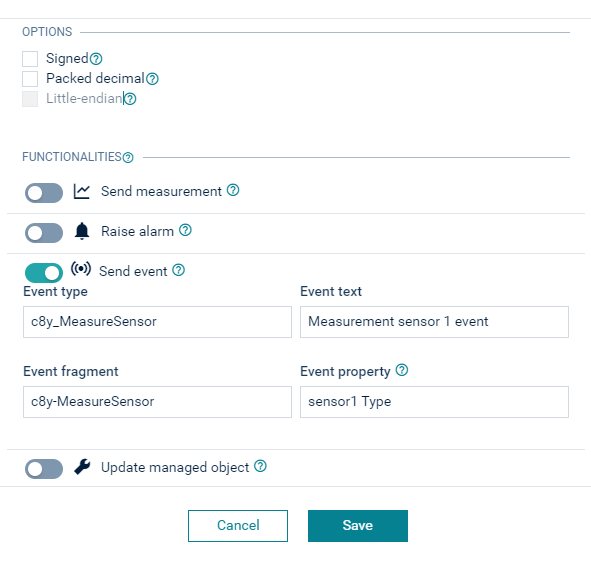
The value configuration maps the value in the payload of a message type to the Cumulocity data.
Under Message type, configure the Message ID according to your device message specification and map it to the Cumulocity data. The message ID is the numeric value identifying the message type. It will be matched with the message ID found in the source specified on the device protocol main page (that is, Payload or FPort). The message ID must be entered in decimal numbers (not hex).
In this example payload structure the message ID is “1”.

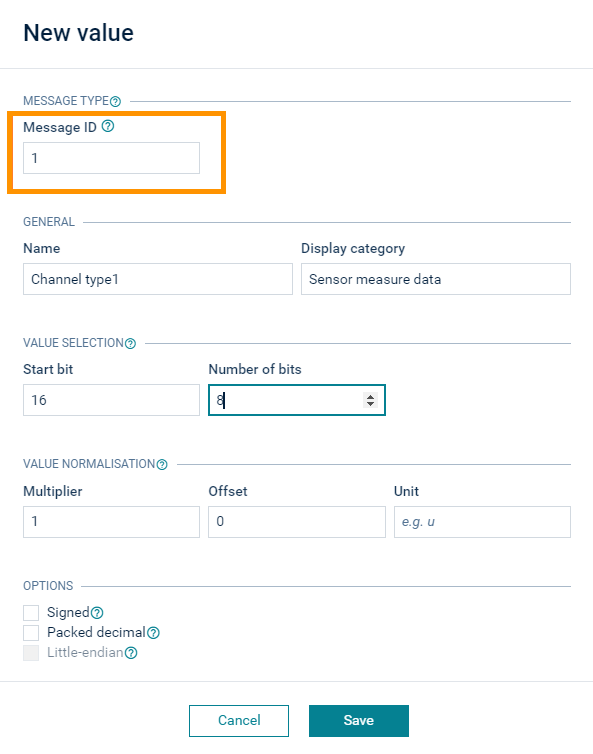
Under General, specify a name for the value and the category under which it will be displayed in the values list. The associated name for this value will be displayed under the Display category given.
Under Value selection, define from where the value should be extracted. In order to do so, indicate where the value information starts in the Start bit field and how long this information is in the Number of bits field. The maximum value for the number of bits is 32 bits (4 bytes).
In this example the “Channel 1 Type” information starts in byte 2 (that means, start bit = “16”) and is 1 byte long (that means, number of bits = “8”).

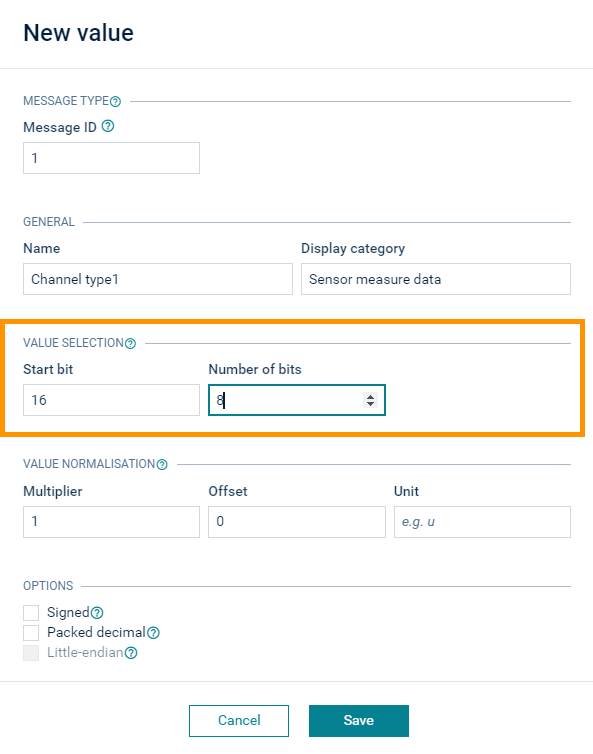
The hexadecimal value is converted to a decimal number and afterwards a “value normalisation” is applied.
Under Value normalisation define how the raw value should be transformed before being stored in the platform and enter the appropriate values for:
- Multiplier: This value is multiplied with the value extracted from the Value selection. It can be decimal, negative and positive. By default it is set to 1.
- Offset: This value defines the offset that is added or subtracted. It can be decimal, negative and positive. By default it is set to 0.
- Unit (optional): A unit can be defined which is saved together with the value (for example temperature unit “C” for degree Celsius).
For detailed information on how to decode the payload, refer to the documentation of the device.
Under Options, select one of the following options, if required:
- Signed - if the value is a signed number.
- Packed decimal - if the value is BCD encoded.
Under Functionalities, specify how this device protocol should behave:
- Send measurement: Creates a measurement with the decoded value.
- Raise alarm: Creates an alarm if the value is not equal to zero.
- Send event: Creates an event with the decoded value.
- Update managed object: Updates a fragment in a managed object with the decoded value.
You can also have a nested structure with several values within a measurement, event or managed object fragment. In case of a measurement all the properties of the same type will be merged to create a nested structure. In case of an event or a managed object all the properties with the same fragment are merged to create a nested structure. Also refer to the example of a nested structure for a “Position” device protocol below.
Click OK to add the values to your device protocol.
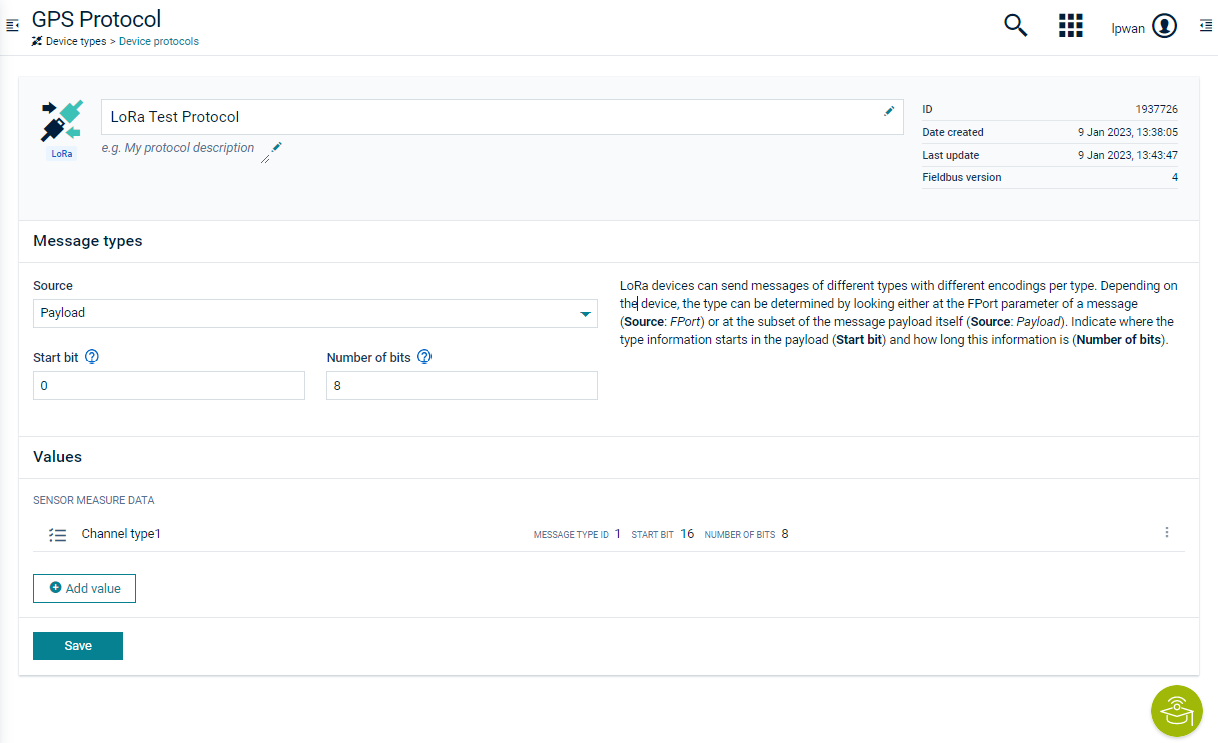
After clicking Save, your device protocol is created with the values you defined.
Example with single property
The following image shows an example for a message which sends a measurement when the battery level changes.
New value window part 1
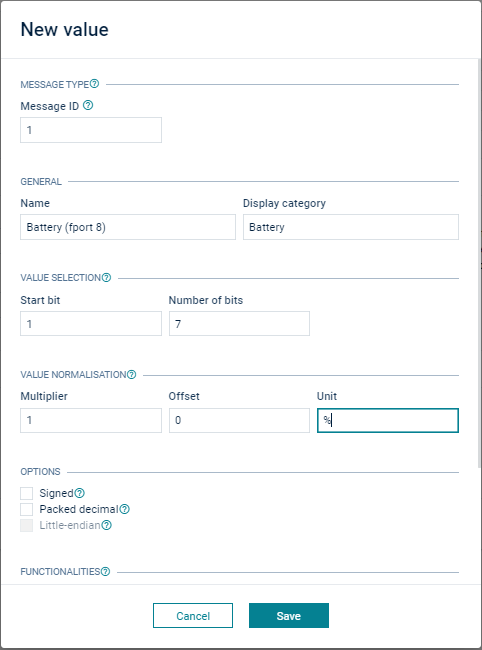
New value window part 2
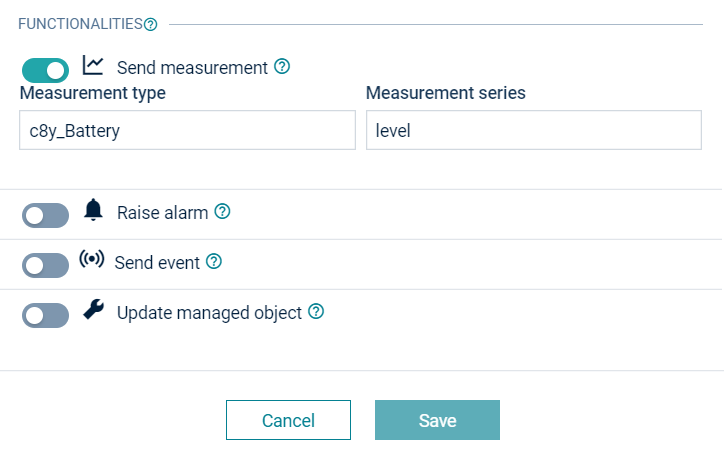
Example with nested structure
The following image shows an example of a nested structure for a device protocol reporting the current position of a GPS device. The display category is named “Position” and contains values for longitude and latitude.
The message ID should be the same for all the values. Enter the rest of the parameters according to the instructions above. Enter “c8y_Position” in the Managed object fragment field and create a new value for each: longitude and latitude.
New value window, Longitude
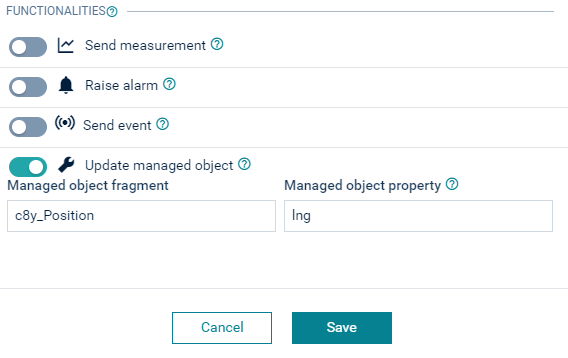
New value window, Latitude
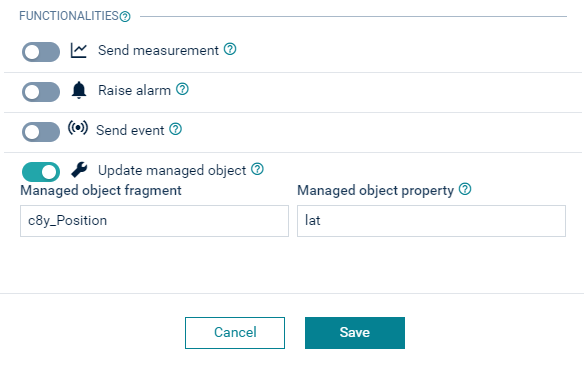
This will be the result:
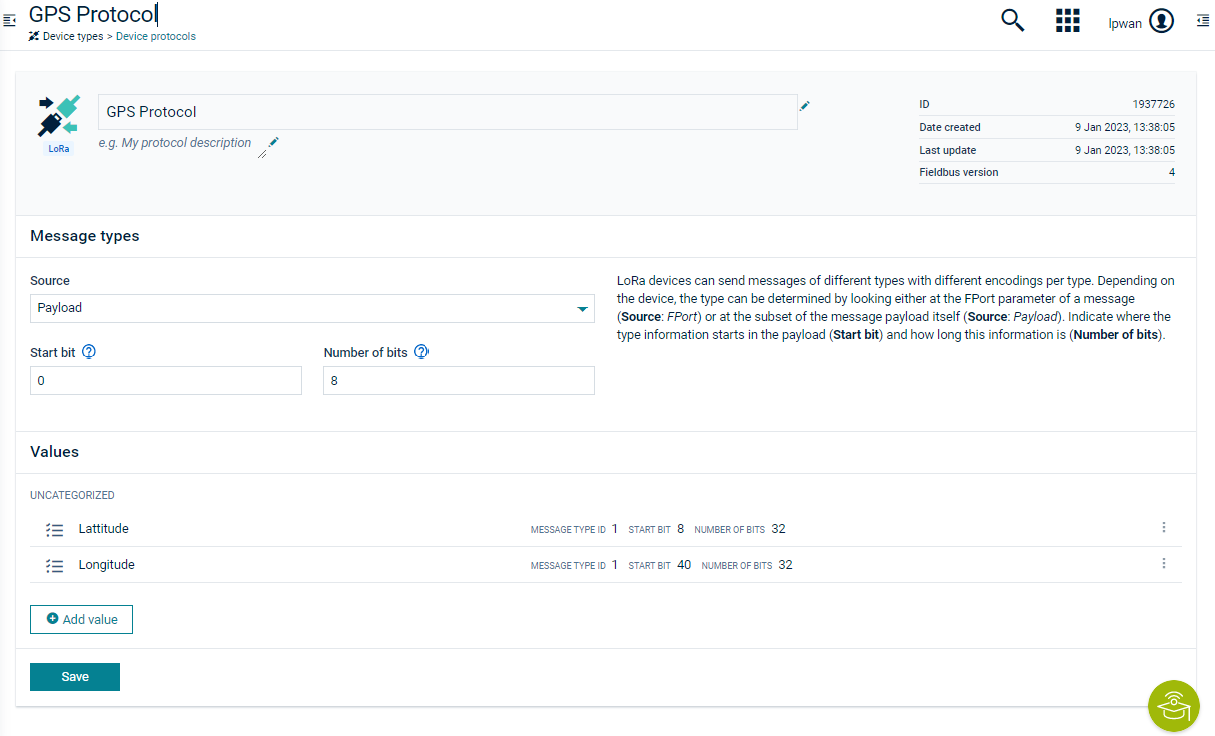
Using custom decoding/encoding
The Actility agent also supports the decoding/encoding functionality by plugging in the custom microservice. Refer to LPWAN custom codec for further details.
Registering LoRa devices
To register a LoRa device in Cumulocity navigate to Devices > Registration in the Device management application, click Register device at the top right and select Single device registration > Actility LoRa from the dropdown.
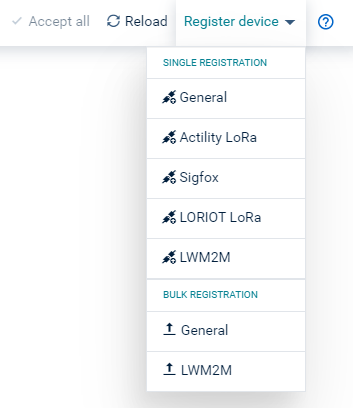
Cumulocity fully supports the LoRa device provisioning with Over-the-Air Activation (OTAA) which is the preferred and most secure way to connect with the LoRa network. If Activation by Personalization (ABP) is required to be used, refer to the LoRa device registration with ABP section.
In the next window fill in the required information:
-
Connection: Lists all configured Actility connections in the tenant. The following device profile and connectivity plan option is populated based on the selected Actility connection.
-
Device profile: Select the Actility Thingpark device profile from the dropdown list that matches the device that you are registering.
The Actility ThingPark device profile allows to manage multi-RF profiles, ensures different LoRaWAN class compatibility (A, B or C) and allows application payload decoding for easy third-party application integration.
-
Device protocol: Select the appropriate device protocol from the dropdown list. For more information on how to create a device protocol refer to Creating device protocols.
-
Device EUI: This is the unique identifier for the device. It is a 16 character (8 byte) long hexadecimal number. You can find it on the device itself.
-
Application EUI: This is a global application ID in the IEEE EUI64 address space that uniquely identifies the application provider of the device. It is a 16 character (8 byte) long hexadecimal number. There can be only one application EUI for a tenant but multiple tenants can have the same application EUI.
-
Application key: This is an AES-128 application key specific for the device that is assigned to the device by the application owner and is responsible to encrypt. The application key is a 32 character (16 byte) long hexadecimal number. JOIN communication. You can find this key on the device itself.
-
Connectivity plan: Select the appropriate connectivity plan from the dropdown list.
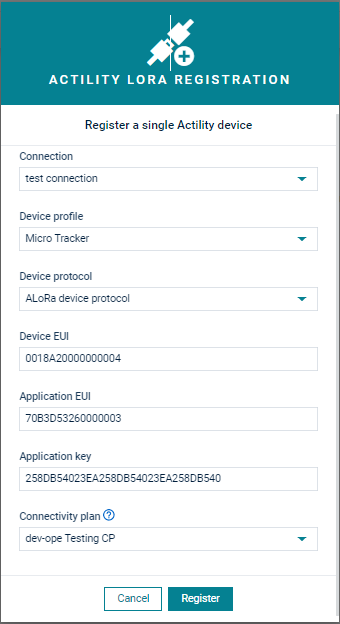
Click Register to submit the device registration request and create the device.
You can verify that the device is really connected by checking that events are actually coming in. You can do so by clicking on a device and opening the Events tab. All events related to this device are listed here.
The provision status is shown under Device data in the Info tab of the device.
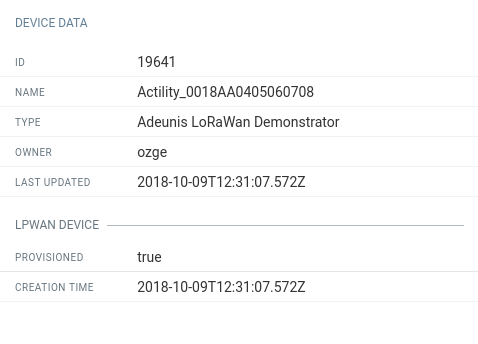
For more information on viewing and managing your connected devices, also refer to the Device management application.
In order to migrate the device from one LNS Connection to another, the device must be re-registered. Navigate to the LPWAN tab of the Device. Click on the Provider connection dropdown. A prompt will appear stating that in order to migrate the device from one LNS connection to another, you must re-register the device. Click on the Re-Register button.
The user is directed to the device registration page where he can perform the re-registration by following the steps above and selecting the desired LNS connection.
LoRa device registration process
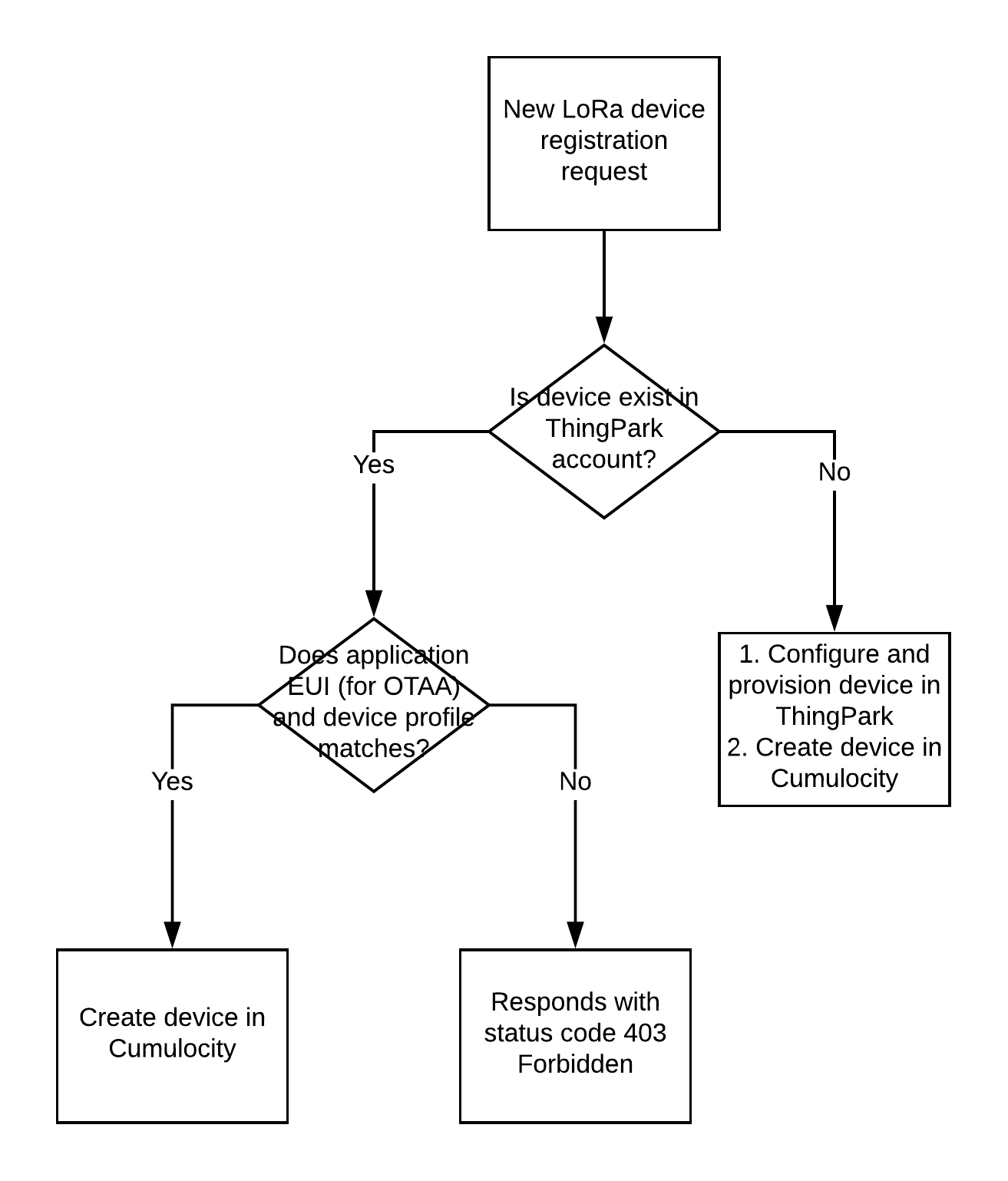
A device is created based on the above workflow.
First it is checked, if the device already exists. If no device exists with the same device EUI in the ThingPark account, the device is first provisioned on the ThingPark platform and then created on the Cumulocity platform with a link to the device in the ThingPark platform. If the device exists in the ThingPark account, a validation will be applied to compare these devices based on application EUI (for OTAA activation) and device profile. If the validation is successful, the device is created only in Cumulocity with a link to the device in the ThingPark platform. If the validation fails, a failure message is shown and the device is not created in Cumulocity.
LoRa device registration with Activation by Personalization (ABP)
Activating the device by personalization is not recommended and not fully supported in Cumulocity LoRa device registration.
However, if you would like to create a device with this activation type in Cumulocity and use the LoRa features - such as sending operations to a device, deprovisioning a device and setting LoRa device protocol type with custom device protocol configuration - you must first provision the device in the ThingPark platform. Moreover you must create “AS Routing Profile” for Cumulocity using the destination http://actility-server.cumulocity.com as a “Third Party AS (HTTP)” and assign it to your devices manually. Afterwards, you can register this device using LoRa device registration. In this case, the Application key field in the LoRa device registration is invalid.
Limitations for LoRa devices created with general device registration
The general device registration for LoRa devices is no longer supported.
Existing LoRa devices that have been created in Cumulocity with the general device registration process have limitations. For those devices, it is not possible to send operations to the device, deprovision the device and set the LoRa device protocol type with custom device protocol configuration.
It is recommended to delete and re-register these devices using LoRa device registration to fully use the LoRa feature.
Deprovisioning LoRa devices
You can deprovision a LoRa device in the ThingPark platform. This means that the device will no longer be connected to the network. Its history data will still be available in Cumulocity, but the device will be deleted in ThingPark.
To deprovision a device, navigate to the respective device in the Device management application under All devices. Click More in the top right and select Deprovision device.

After confirming the deprovisioning, the device will be deprovisioned in ThingPark.
To provision the device again, the device should be deleted and re-registered using LoRa device registration.
Sending operations
If a LoRa device supports receiving hexadecimal commands, you can send them using shell operations. Notice that these commands are not serial monitor commands. In order to send an operation, navigate to the device you want to send an operation to in the Device management application under All devices. Switch to the Shell tab.
In the following screenshot you can find some examples of a device protocol’s predefined commands and their format.
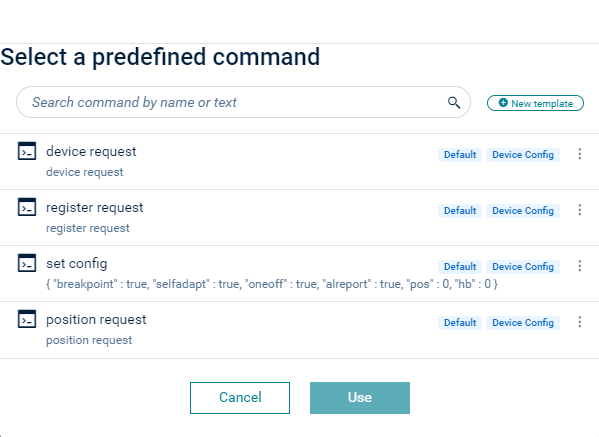
Enter the shell command or view/edit the predefined command in the Command field.
If you enter the command without defining a port, it will be sent to the default target port (that is, port 1) of the device. If you enter the command and define a port (format “command:port”), it will be sent to the specified target port instead of the default port.
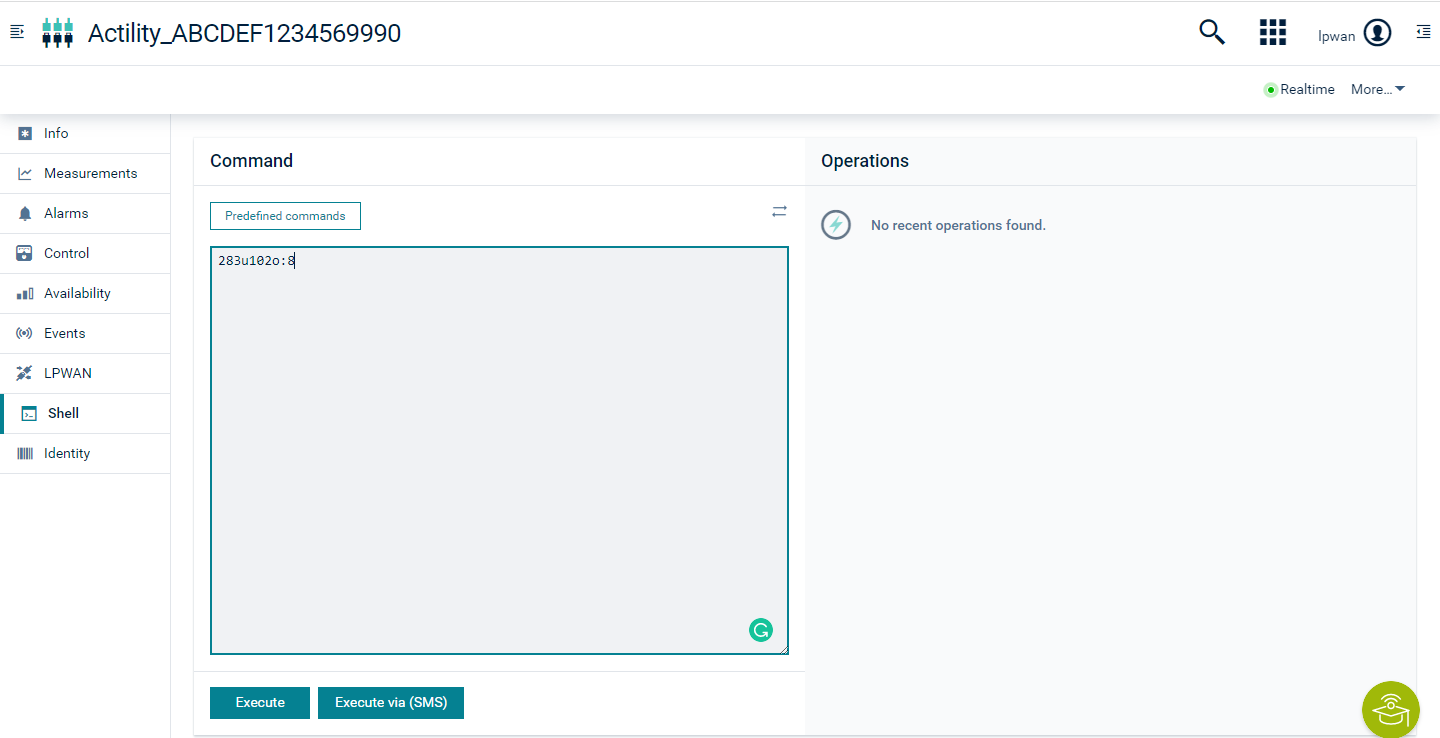
Click Execute. The operation will be sent to the device. The timing depends on Actility ThingPark.
The status of the operation is set to SUCCESSFUL when the operation has successfully been sent to the ThingPark platform. The status of the operation is set to FAILED when a problem occurred with the validation of the command or after the operation has been sent to the Thingpark platform.
ThingPark API availability monitoring
The ThingPark API is monitored and if it is not reachable, an alarm is created to notify all subscribed tenants using this feature. The alarm is cleared right after the ThingPark API is reachable again.
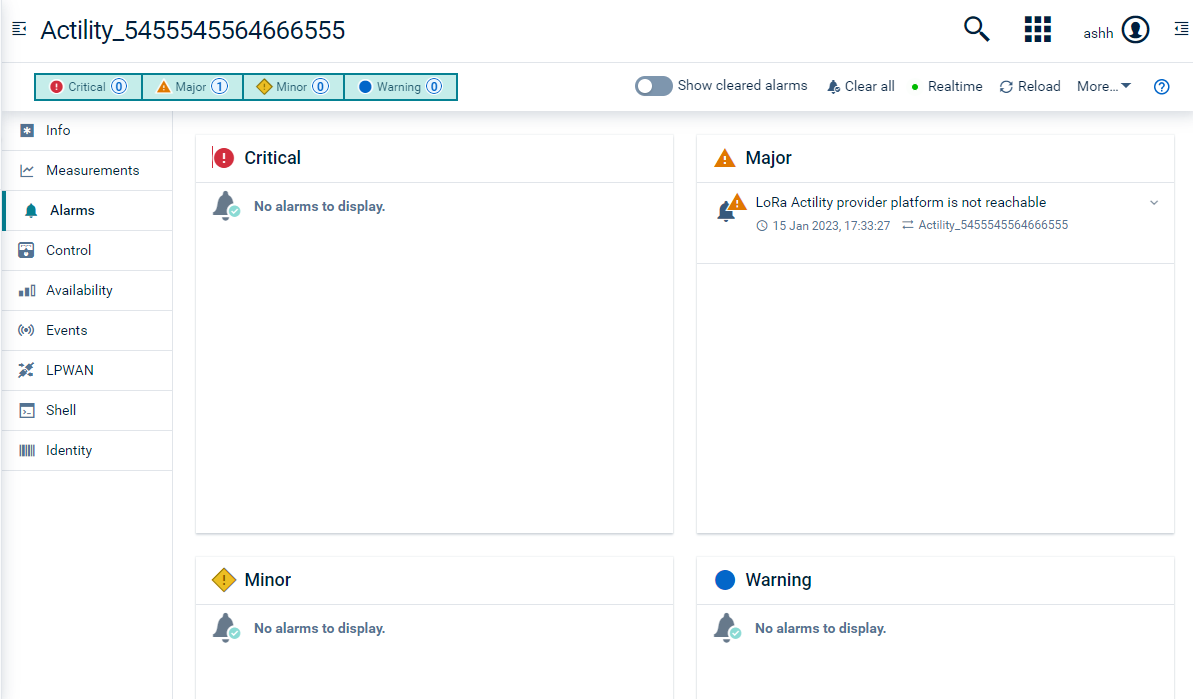
Uplink message processing
On the receipt of an uplink message, the Cumulocity platform creates the following measurements and events, and updates the corresponding device managed object.
- Unprocessed data - An event of type
c8y_ActilityUplinkRequest(this type is based on the event.uplink.type set in the configuration file) is created with the unprocessed data. - Position - The
c8y_Positionfragment of the device managed object is updated to capture the latitude, longitude, altitude and accuracy information of the device. Also, an event is created with the position information. - Spreading factor - The
c8y_SpreadingFactorfragment of the device managed object is updated to capture the spreading factor of the device. - Signal strength - A measurement is created with RSSI and SNR values of the device signal strength.
Troubleshooting
Device registration
Access to device denied
This warning message shows up when there already exists a provisioned device in ThingPark with the same device EUI used for device registration and the validation comparing those devices based on application EUI (for OTAA activation) and device profile has failed.
To resolve this, provide the correct application EUI from Connectivity application and device profile and try again.
No LoRa provider settings found
This warning message shows up when there are no credentials set up for the ThingPark account. To resolve this click Settings to navigate to the Administration application where the connections are configured.
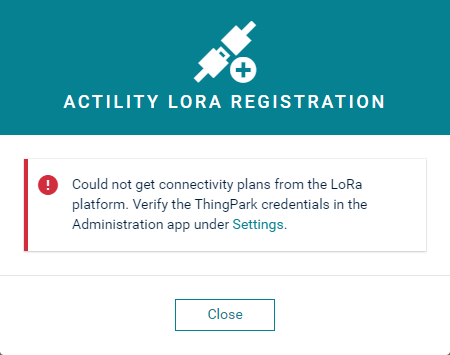
To resolve this, refer to Configure ThingPark credentials.
Getting device profiles from provider failed
This warning message shows up when the tenant’s access token to Thingpark becomes invalid. Invalidation of the token might happen when the same ThingPark credentials are used for another tenant.
This issue can be solved by reconfiguring the Actility ThingPark credentials to renew the access token. Refer to configure ThingPark credentials for reconfiguration of the credentials.
No device protocols configured
This warning message shows up when no LoRa device protocol exists to be used for device registration. To resolve this, click Device protocols to navigate to the Device protocols page where the protocols are configured.
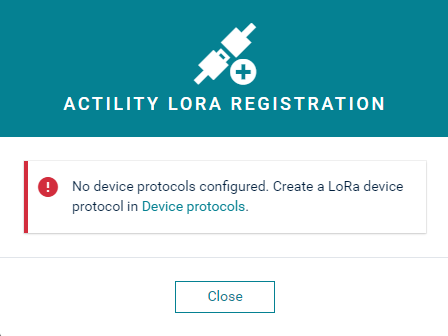
To resolve this, configure at least one device protocol in the Device database.
No connectivity plans with free slots available
This warning message shows up when the connectivity plan in Actility ThingPark has reached the limit for the device count.
To resolve this, either contact ThingPark on the device quota limits for your connectivity plans or remove unused devices from ThingPark and retry registering the device in Cumulocity.
Connectivity
Authorization to the LoRa platform failed
This warning message shows up if a provided profile ID, username or password is invalid.
To resolve this, provide correct credentials and try again.
Authentication to the Actility platform failed. Check if the base URL is correct.
To resolve this, provide a correct URL and try again.
Authentication to the Actility platform failed with status code ‘400’. Check if the profile ID is correct.
To resolve this, provide a correct profile ID and try again.
Authentication to the Actility platform failed with status code ‘401’. Check if the credentials are correct.
To resolve this, provide a correct username and password and try again.
